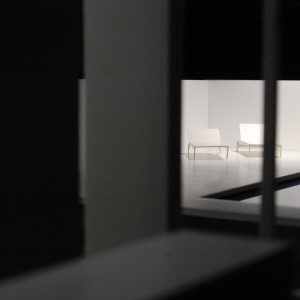In which an architect and a photographer compose an audovisual story live on stage. It’s all very simple – well, deceptively simple. It’s actually all very cleverly thought out and constructed.
At first, you notice – or at least, I noticed – two main focal points on the stage. Architectural models of buildings, one a modernist box, the other more of a ‘doll’s house’ house. There are two performers – or animators of the space is perhaps a better term. One, Steve Salember, fiddles with the models, adds and subtracts, rearranges. The other, Charlotte Bouckaert, places herself as the viewer, and, camera in hand, takes images which are then projected in enormous scale on the back wall. But she isn’t merely the viewer, the witness. She becomes the architect of the new onscreen space. The very act of taking the pictures of the space changes the space; changes our relationship to what we are seeing.
What are we seeing? We see what seems to be a deserted warehouse or aircraft hangar. We see a disrupted dinner party. So many of these images are about absence; the show becomes a photo album of absence. Where are all the people in these monochrome worlds?
The other crucial element is that of sound. This short work – just 35 minutes – relies on the soundscape (a mix of live and pre-recorded) to help create the dramaturgy of the piece. Example: we hear the sound of a ping-pong ball bouncing off of a table. Then lots of ping pong balls. The sound grows and resonates until it become a cacophony. On screen we see one ping pong ball bouncing. Then we see a roomful, appearing to cascade down onto a table. At the end of the show, when I look at the models on the way out, I see one ping-pong ball in a box, and I see that in the room with the tiny doll-size table a chairs, a cluster of tiny polystyrene beads portraying the table-tennis balls. ah yes, of course. There are also moments when Steve Salember goes and sits and plays guitar. A nice addition, although I’m not sure what it adds to the dramaturgy of the piece. Perhaps it is because it is another parallel way that he can craft the space; the aural landscape?
The stories are created by the performers in the space; and they are created by us, in our heads. We see what the architect has designed, and/or we see what the photographer is focusing on and is framing, and/or we see what we want to see. As the piece progresses, the focus shifts to other little models or boxes in the room, each lit in turn – five or 6 in total – and then on the floor itself. But the mediated image, the screen, is all dominant, it is hard to pull your eyes away from it – and I think that is the point.
I love the fact that we see the stories unfold in still images, rather than moving image. I love the quiet presence on the performer/animators, gentle giants in their domain, benign gods. I love the stories that unfold, and seem to ultimately take us away from a man-built world and into a more primal world of waves and duststorms and sticks drawing in the sand.
A quietly beautiful and meditative show, a world away from the razz-a-ma-tazz of much of the rest of the Fringe.
Bildraum won a Total Theatre Award 2016 in the Physical/Visual Performance category. It is presented at Summerhall as part of the Big in Belgium programme of work.

